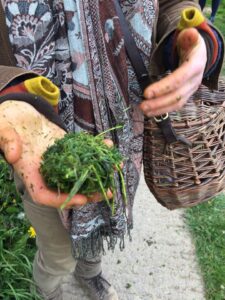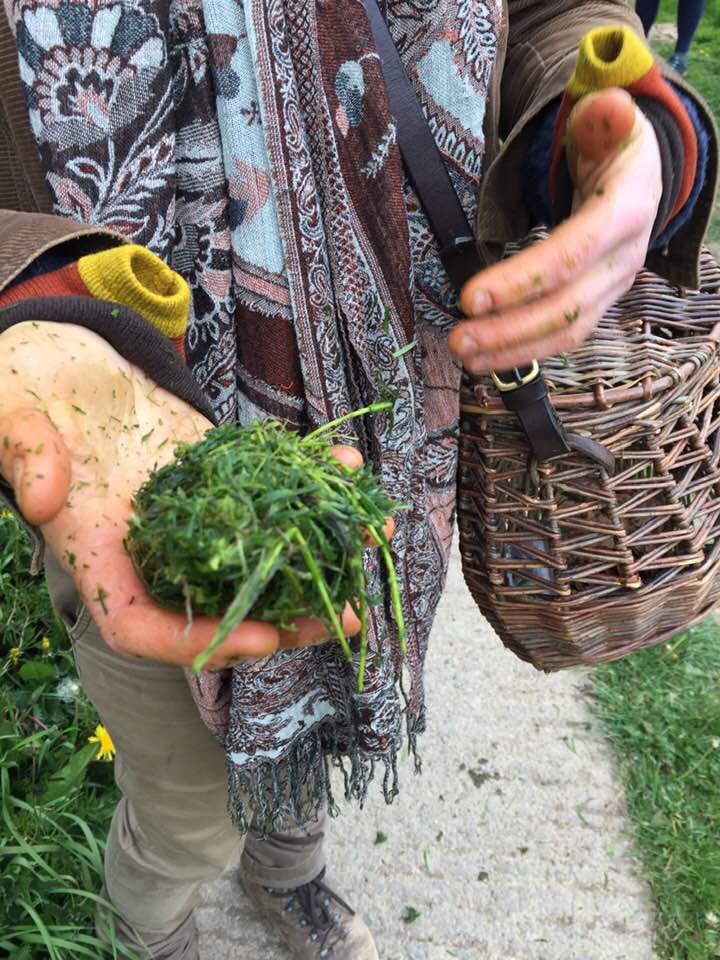Our Sacred Waters Way downstream pilgrimage began on a sunny Sunday afternoon in early May, with a gentle wander from the ‘new’ (Victorian) St Mary’s church in Dartington to the ‘old’ (medieval) St Mary’s Tower. Myrtle Cooper of Wild and Curious Foraging took our wild church practice of ‘wandering and wondering’ to heart, as she beautifully guided us through the tall trees of North Woods and along the River Dart, before bringing us up the edge of the deer park and to the ancient yew at the sacred heart of the Dartington Estate.
 Early in the walk we paused by the Forest Garden near Schumacher College to meet the first of a series of wild plants – cleavers (galium aparine). Myrtle invited us to contemplate its strong upright growth into the hedgerow, which relies entirely on water. Taking a bundle of leafy stems, she squeezed out a handful of juice, demonstrating her point and encouraging us to take our own taste of this healing plant which may support the immune system and have diuretic, antispasmodic, and anti-inflammatory effects. This theme of hidden waters remained with us throughout the walk, as we paused in damp places and contemplated how water flows not only in the obvious streams but through the earth, plants, trees and our own bodies.
Early in the walk we paused by the Forest Garden near Schumacher College to meet the first of a series of wild plants – cleavers (galium aparine). Myrtle invited us to contemplate its strong upright growth into the hedgerow, which relies entirely on water. Taking a bundle of leafy stems, she squeezed out a handful of juice, demonstrating her point and encouraging us to take our own taste of this healing plant which may support the immune system and have diuretic, antispasmodic, and anti-inflammatory effects. This theme of hidden waters remained with us throughout the walk, as we paused in damp places and contemplated how water flows not only in the obvious streams but through the earth, plants, trees and our own bodies.
Soon we were leaving the path to move deeper into the woods, pausing along the way to nibble on other wild edibles, including wild garlic (allium ursinum), wood sorrel (oxalis acetosella) and tender young beech (fagus sylvatica) leaves. Then clambering down to a stony beach beside the Dart, Myrtle introduced us to some highly poisonous plants, monkshood (aconitum napellus) and hemlock water dropwort (oenanthe crocata), reminding us how important it is to know what we are doing before tasting plants in the wild. We gathered safer wild tokens such as autumn leaves, twigs and stones to be released into the water – letting go of last winter and launching intentions for the spring and summer to come.
As we walked up the deer park wall, we paused to watch the spotted fallow deer doing their own wild foraging, while we tasted some spicy garlic mustard (alliaria petiolata) from the path side. We concluded with a wild communion of water mint tea and shared reflections, as we sat beside the ancient yew (also a predominantly poisonous plant) and considered her 1500 years of drawing up and growing out water… her own long pilgrimage through time is another kind of profoundly sacred waters way.
Words and image by Sam – For more photos click here.

